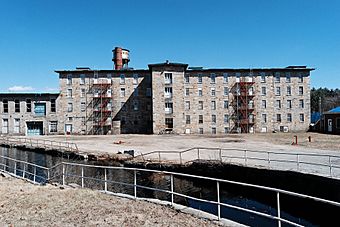Hope Village Historic District facts for kids
The Hope Village Historic District is a special historic area in Scituate, Rhode Island. It's a old village that grew around a mill. Hope Village is located near the Pawtuxet River. People have been working in industries here since the mid-1700s. Many of the old factory buildings and homes from the early 1800s are still standing today.
The village center is where Main Street (Rhode Island Route 115) meets North Road (Rhode Island Route 116). From this center, houses spread out onto smaller streets, all close together. Today, there isn't much business or factory work happening in the historic district. The main stone mill building was built in 1844. It was later made bigger in 1871 and changed again in 1910. About a quarter of the homes in the village were built for the mill workers.
Hope Furnace: Making Cannons for War
An iron factory called the Hope Furnace was built in 1766. This happened soon after iron ore was found nearby in 1765. The factory made things for homes, like cooking pots. It also made pig iron, which is a basic form of iron.
The Hope Furnace got an important job during the American Revolutionary War. It was asked to make cannons for the Rhode Island government. These cannons were used to fight for America's freedom. The factory ended up making 270 cannons! Hope Furnace stopped making things around 1801. The land was then sold in 1806.
Hope Mill: A Textile History
In 1806, a new factory was built along the Pawtuxet River. This was the Hope Cotton Factory Company. It was located southeast of where the Hope Furnace used to be. This area later became known as Hope Village. The first mill building was made of wood.
Over the years, the mill buildings changed owners several times. In 1844, the wooden mill buildings burned down. They were replaced by a large, four-story stone building. This new building had a pointed roof and a bell tower. It was built by a company from Providence called Brown and Ives.
Around 1900, a big, one-story brick building was added next to the stone mill. The pointed roof of the original stone mill was replaced with a flat roof. A fifth floor was also added to the stone mill.
The Hope Mill buildings were used to weave fabrics until 2007. The last company to make textiles there was called Just-A-Stretch. They wove stretchy fabrics.
Sadly, between 2016 and 2019, parts of the mill buildings started to fall apart. The roofs and walls of the brick building collapsed. Some roofs of the stone mill buildings also fell in. The Hope Mill property had been neglected for many years.
In August 2023, the town of Scituate decided to tear down the mill. This was because the buildings had decayed so much. The demolition was planned to be finished by 2024.
Life in Hope Village
After Brown and Ives bought the mill in 1844, they built several houses. These homes were for the people who managed the Hope Mill. In 1874, a church was built next to the mill. A library was even set up in the church's basement.
Thirteen special houses were also built for the mill workers. These were double-tenement houses, meaning each building had two separate homes. They were located on Mill Street, north of the mill.
By the early 1880s, Hope Village was a busy place. It was the end point for the Pawtuxet Valley Railroad. This train line started running to Hope Village in 1874. Several shops opened in the village because of the train. The train tracks in Hope were removed in the 1950s.
The Hope Village Historic District was added to the National Register of Historic Places on August 8, 1995. This means it's recognized as an important historic site.




